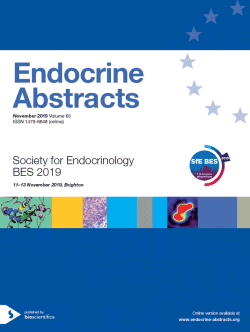Searchable abstracts of presentations at key conferences in endocrinology

Society for Endocrinology BES 2019
Brighton,
United Kingdom
11 Nov 2019 - 13 Nov 2019

Come and exchange knowledge, share experiences and strengthen collaborations across our global community of endocrinologists!
SYMPOSIA
Phosphate homeostasis physiology, pathology and pharmacology
ea0065s3.1 | Phosphate homeostasis physiology, pathology and pharmacology | SFEBES2019
FGF23 signalling and physiology
Fibroblast growth factor 23 (FGF23) is a phosphotropic hormone that belongs along with FGF19 and 21 to a subfamily of endocrine FGFs with evolutionary conserved functions, which can be demonstrated in the gut of C. elegans and in the kidney tubules of fruit flies. FGF23 is posttranslationally regulated by phosphorylation through FAM20C, which causes its proteolysis through the subtilisin-like proprotein convertase FURIN, and results in secretion of FGF23 fragments. O-glycosyla...
ea0065s3.2 | Phosphate homeostasis physiology, pathology and pharmacology | SFEBES2019
Phosphate-sensing update: interplay between FGF23, phosphate, and phosphate-sensors
Bon Nina , Beck-Cormier Sarah , Beck Laurent
Despite significant progress in understanding the regulation of phosphate (Pi) homeostasis over the past 20 years, the mechanisms underlying the very early step leading to the regulating cascade involving multiple hormones (PTH, vitamin D, FGF23) and organs (kidney, intestine, bone, parathyroid glands) are not deciphered. Progress in this area is based on on the ability to identify and characterise the Pi-sensing mechanism in mammals that allow cells or organisms to detect cha...
ea0065s3.3 | Phosphate homeostasis physiology, pathology and pharmacology | SFEBES2019
FGF23-related hypophosphatemic diseases: prospect for new treatment
FGF23 is a phosphotropic hormone produced by bone. FGF23 23 reduces serum phosphate by suppressing proximal tubular phosphate reabsorption and intestinal phosphate absorption. Since the identification of FGF23 in 2000, several hypophosphatemic diseases such as X-linked hypophosphatemic rickets (XLH) and tumor-induced osteomalacia (TIO) have been shown to be caused by excessive actions of FGF23. TIO is a paraneoplastic disease and can be cured by complete removal of responsible...



